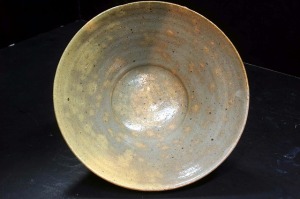 Idle Chat about Korean (Kourai) Tea Bowls (2)
Idle Chat about Korean (Kourai) Tea Bowls (2)
Totoya/Soba
by TANI Akira Curator of the Nomura Museum of Fine Art
The Origin of the Name “Soba (Buckwheat)”
Unlike totoya tea bowls, here are not different types of soba tea bowls. A soba bowl’s is short compared to the width of it’s mouth, and it’s sides are level. The outer part of the foot is whittled down to a width of a few milimeters, and the bowl’s waist is narrow. Generally, the glaze covering it is thin. A glaze the colour of a pale loquat is common, but some of them are coloured a blue, and there are bowls that seem to have the glaze for half the body substitue the the blue colour for loquat colour.
An explaination on the origin of the name “soba” comes from it being “ido no soba” (lit. near the ido), in it resembles an ido tea bowl. In fact, the paper inside the box of the soba chawan called “Fujinami” held in the repository of the Nomura Museum says that that tea bowl is as an ido bowl. If one looks at it with modern eyes, it would be little thought of as a type of ido chawan, but formerly the generally idea of an ido bowl was probably a bit different than in modern times.
Finally, there are black spots scattered inside the soba bowl, the name “soba” is explained as these spots resemble the sediment of buckwheat. Anyhow, the truth of the matter is we don’t know why there is different name for a bowl of such similar type as the totoya.
Investigating Kiln Markings
There are those who say True Totoya have characteristics of chawan made in the area of Hoeryŏng of North Korea. Those characteristics are a solid foot and that inside and the area around the foot are left unglazed. Since we cannot do feild excavations to investigate the Hoeryŏng theory as the area currently is controlled by North Korea, we really cannot make a judgement. But we can identify characteristics that resemble chawan from the first period of karatsu.
In any event, as soba and totoya chawan look comparitively alike, we often find fragments of them with kiln markings from the Gyeongsangnam-do in the west to Jeollanam-do in the east.
However, even the Wakan Kiln of Pusan managed by the Tsushimi Province is thought to have made both totoya and soba bowls. As for works handed down unto today, it is thought likely that many of them are artefacts from Wakan Kiln.
Furthermore, according to excavation reports, totoya and soba have been found at a large quantity of archaeological excavations in Japan . Actually, looking at excavated fragments, their condition is fairly different from the totoya and soba of chanoyu. The reason why is that the lead archaeologist classifies a bowl mainly by the treatment of the foot and it’s shape, but in chanoyu we consider the whole feeling of the chawan. Thus even when seeing a nearly completely intact artefact we often cock our head thinking “Is this really a soba chawan?”The veiwpoint of an archaeologist–who considers the technical characteristics of the fragments–and the veiwpoint of chanoyu enthusitist–whose classification considers not only the general shape and colour, but the feeling of the bowl–are different. It’s likely this difference that brings about such a result.
蕎麦の名称の由来
これに対して蕎麦は斗々屋のようにいくつがのタイプがあるのではなく、口径に対して高さが低く、見込は平らになっており、高台の外側が数ミリの巾(はば)で削られ、腰部にくびれがあります。釉薬は全般的に薄く掛けられ、白っぽい枇杷色に発色しているものが多く、なかには青く発色したり、枇杷色の青色が片身替わりになったように見えるものあります。
蕎麦の名前の由来は、井戸茶碗に似ていて井戸の側(そば)がということからとの説があります。事実、野村美術館が所蔵する「藤波(ふじなみ)」の銘を持つ蕎麦茶碗の箱の中に入っている紙片は、この茶碗を井戸としています。ただ現代の目からすれば、井戸茶碗に分類するのはちょっとと思われますが、かつては井戸の概念が現在とはやや異なっていたかもしれません。
また、蕎麦のなかには黒い点が混じるものがあり、これを蕎麦糟に見立てて名前がついたとの説もあります。いずれにしても斗々屋同様名前の由来はよくわからないというのが実情です。
窯跡に関する調査
本手斗々屋には北朝鮮の会寧近辺で作られた茶碗の特徴があるという人もおり、その特徴はがっしりした高台と高台内部やその周辺に釉薬が掛かっていないところです。会寧説についてはそこが現在北朝鮮に属していて現地調査ができませんので、なんとも判断しかねますが、唐津の初期の茶碗とそうした特徴が似ていることが指摘できます。
いずれにせよ蕎麦と斗々屋は比較的よく似た茶碗で、慶尚南道西部から全羅南道東部にかけての窯跡でそれらの破片をよく見かけます。
ただ対馬藩の経営した釜山の倭館窯でも、斗々屋・蕎麦共に作られていたと考えられており、伝世品では倭館窯の製品が多いであろうと思われます。
なお考古学の日本における発掘報告書には斗々屋や蕎麦の出土例を大量に見かけますが、実際に出土した破片を見ると茶の湯でいう斗々屋や蕎麦とはかなり様子が異なります。その原因は、発掘担当者はもっぱら高台の処理や形状でタイプを判断するのに対して、茶の湯では茶碗の待つ全体的な雰囲気を重視するためで、仮に完品に近い出土品であっても「これが蕎麦茶碗?」と、首をひねってしまうことがよくあります。これは破片の技術的な特徴を重視する考古学の立場と、もっぱら形や色だけでなくそれが持つ雰囲気などを重視して判断する茶の湯の立場との相異が、そのような結果をもたらしているのであろうと考えています。
Leave a comment